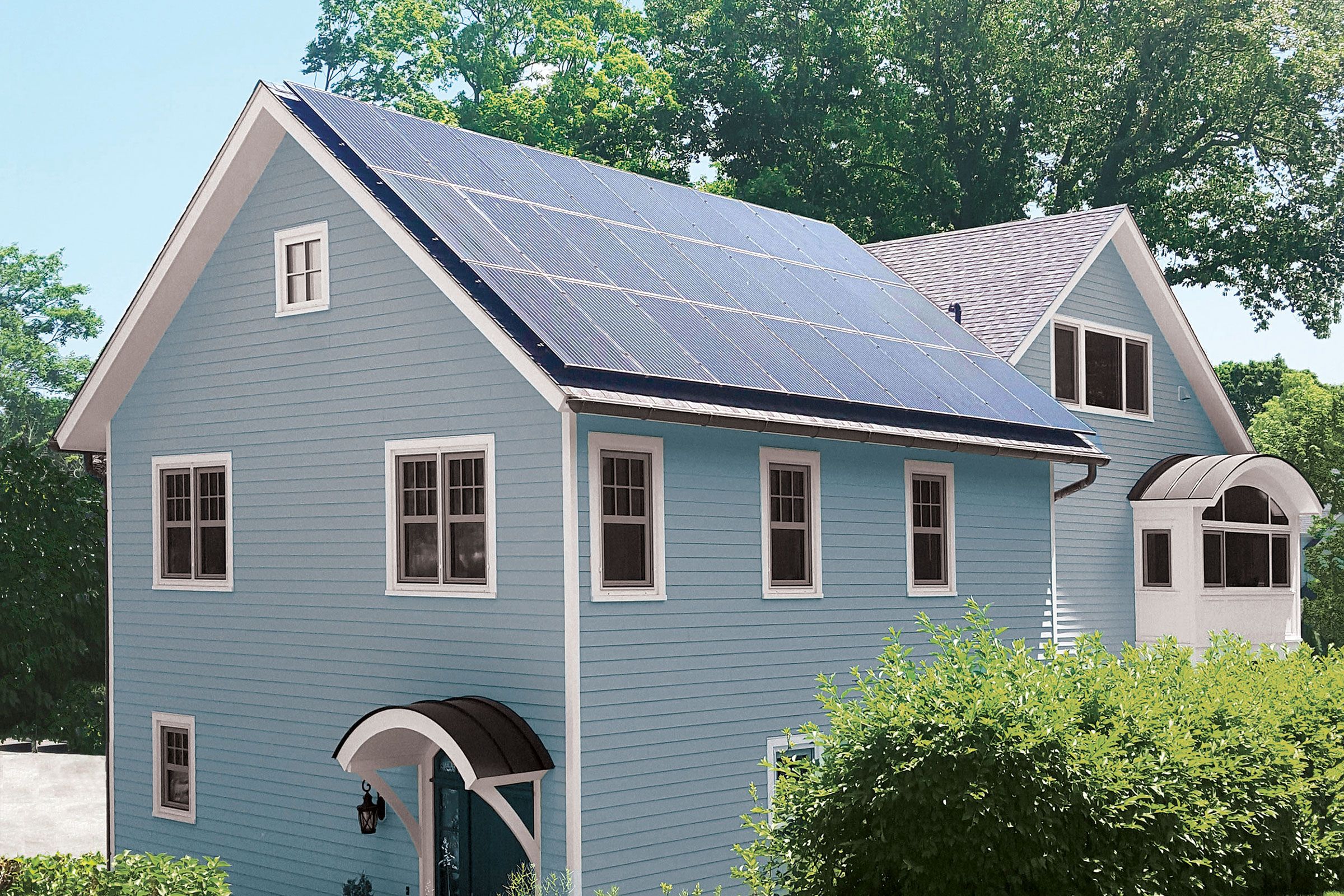This article appeared in the Fall 2022 issue of This Old House Magazine.
A century after electricity started brightening most U.S. homes and powering pop-up toasters, a second electrification of American life has begun—this one aimed at reducing the use of fossil fuels. Car manufacturers will introduce dozens of new electric vehicle (EV) models in the next couple of years, taking affordable EVs deep into the mainstream.
Induction cooktops are seeing a drastic increase in market share, and several cities have banned new residential natural-gas hookups altogether. Meanwhile, all- climate heat-pump technology now makes heating and cooling with electricity less costly than using natural gas.
Largely driven by concerns about climate change, the trend to plug-in power also presents an opportunity to slash your energy costs by generating your own electricity on your roof. A recently extended federal tax credit will give you back 26 percent of the cost for solar-panel installations in 2022, and 22 percent for those in 2023. (The credit will end after 2023, unless it’s extended by Congress.) And even though prices have bounced slightly in the last couple of years due to inflation, they are still way down overall, after dropping 64 percent between 2010 and 2020.
The tech has gotten better, too—a lot better. The standard panel is now all black, without the noticeable white grid lines that make it stand out on the roof, and generates as much as 450 watts, up from 340 five years ago. You can get panels that are more than 20 percent efficient—compared with just 13.5 percent in 2001—and if that doesn’t sound impressive, consider that the best plant photosynthesis is around 8 percent efficient.
What’s more, hidden racking systems help blend the panels into the roof, and you can add EV chargers powered by your system and a battery backup that will eliminate blackouts. Ready to consider going solar? Here’s how to go about assessing your options.
How does a PV Array Work?
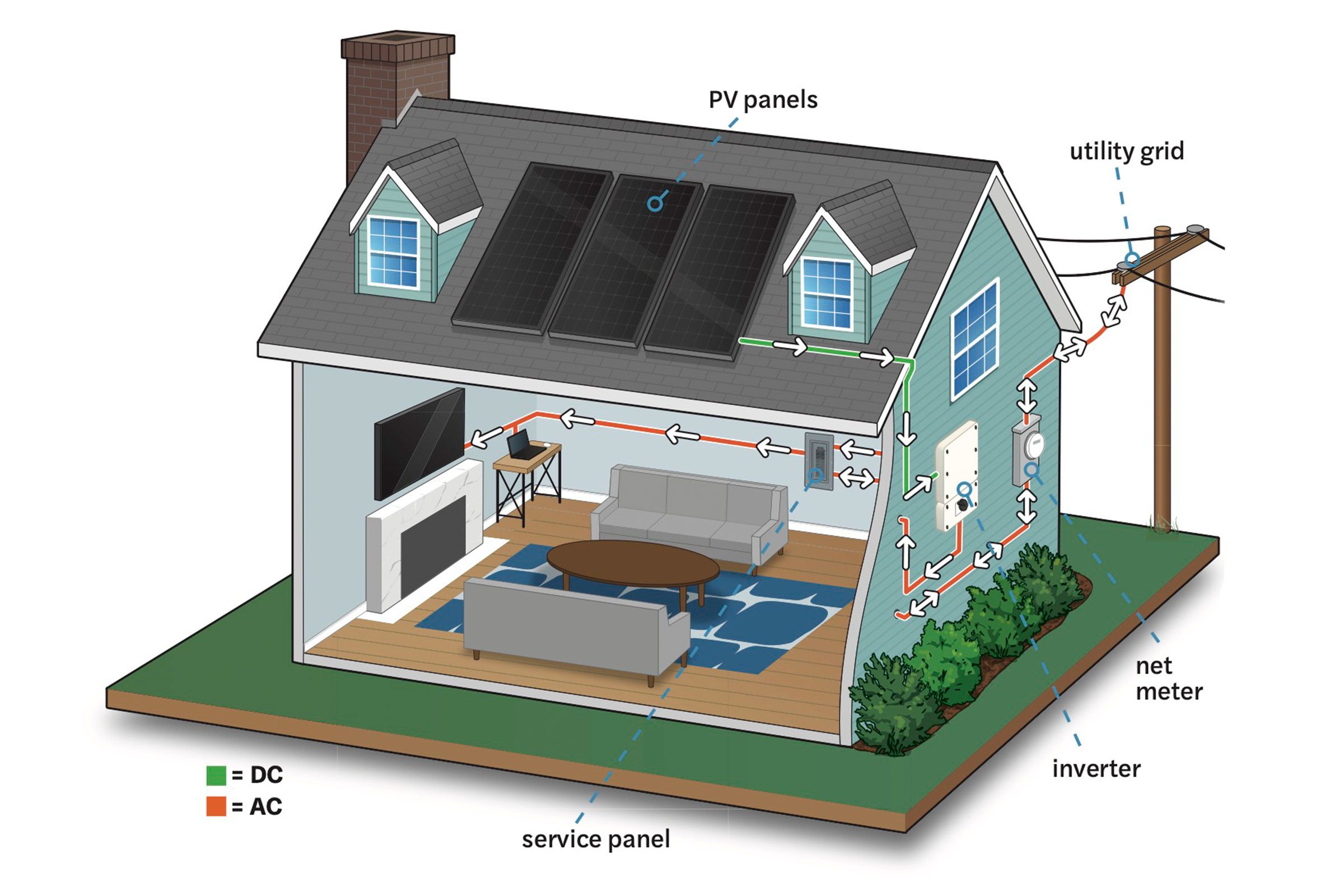
Going solar doesn’t mean disconnecting from the power grid. Since solar panels generate electricity only when the sun is shining, you still need to draw power from the utility at night, on cloudy days, and in some locales on winter days when the sun is low on the horizon. Your system will generate extra power when it is getting full sun in the middle of the day and push it out to the grid for others to use, and then take what it needs from the utility when your solar is offline. Ideally, over the course of the year, that give-and-take will even out, and you’re left with no net usage and only nominal connection fees to the utility.
PV Panels: The 60 photovoltaic (PV) cells typically found in residential panels absorb sunlight and use it to knock electrons loose and get them moving—in other words, to generate electricity.
Inverter: This device converts the direct current (DC) electricity generated by the panels into the alternating current (AC) that your house’s electricity-powered systems and plug-in devices need.
Net Meter: Like all electrical meters, this measures how much electricity you draw from the utility. Unlike others, it also reverses and credits you for what you contribute back to the utility grid.
The Cost of Solar Panels
Will installing solar pay for you?
In most of the United States, it can take from 9 to 12 years for your energy savings to pay. back the cost of a solar system (5 to 15 years when you include outlier states like Hawaii and North Dakota); then your solar should provide free power for as long as two decades more.
The payback period depends on your latitude, the direction your roof faces, the amount of tree cover, the cost of electricity in your area, and your utility’s policies. For an instant estimate of your total cost, annual dollars saved, and payback period, plug in your address and average monthly electricity cost at Project Sunroof.
Financing solar
Though it depends a lot on where you live, a typical rooftop solar array (20 to 24 panels to cover an average home’s electrical needs in full) runs about $18,000 after the current 26 percent federal tax credit. You can finance the upfront cost—most people do—and the choice you make will have a drastic impact on your payback. Here are the options.
Solar lease
A solar- installation company puts in the system and owns it. You pay a predetermined monthly fee for the next 20 or 25 years. Leases have a few downsides: The solar company gets the tax credit and other incentives, your monthly payments can increase over time, and your projected savings rely on the company’s assumption of future electricity rates, which may be buried in the fine print and, if overstated, could potentially make your solar more expensive than utility power. Plus, if you sell your house before the lease is up, you’ll have to buy out the lease (including the cost of the equipment) or transfer the lease to the buyer; it rarely pays to move the system to your new home.
Solar loan
Again, the solar company installs the system at no upfront cost to you, but in this case, you get the tax credit and any other available incentives, and you own the equipment, so it becomes part of your house, easily included as one of its features if you decide to sell. You pay back the loan monthly and generally can select the length of the loan you want—for example, to pay it back as quickly as possible while keeping the payment about equal to your current electricity bill. If you sell the house before the loan is paid back, the solar array transfers to the buyer, and you can pay back the loan in a lump sum using proceeds from the sale. Many solar companies offer below-market interest rates, but watch out—that discount often comes with a marked-up price, so always make sure the loan and the cash price are the same.
Home equity loan/HELOC
Borrowing from a local bank or credit union allows you to keep it simple with the solar company and just pay the cash price. If you use a home equity loan (which has a fixed interest rate) or a line of credit (which has an adjustable rate), you may be able to take a tax deduction for the interest. Again, you pay for the solar install in full using the loan, own the system, and can easily sell it with the house, collect all incentives, and pay the loan back over time—or in full when you sell the house, as part of the closing.
Resale with solar panels
“Houses with solar sell faster, and they sell for more money,” says agent Theresa Raymond of TN Smoky Mtn Realty. “We’re seeing a $5,000 bump in price for each kilowatt.” That’s about $30,000 for a typical 6.5-kilowatt system, significantly more than you’ll pay for it.
TOH Pro Tip: Solar power makes a lot of sense, and it’s come down so much in price that it’s now affordable for many more people. But like any tech, it needs to be designed and installed correctly to yield the best performance and return on investment.” -Ross Trethewey, TOH home technology expert.
How to Hire a Solar Panel Installer
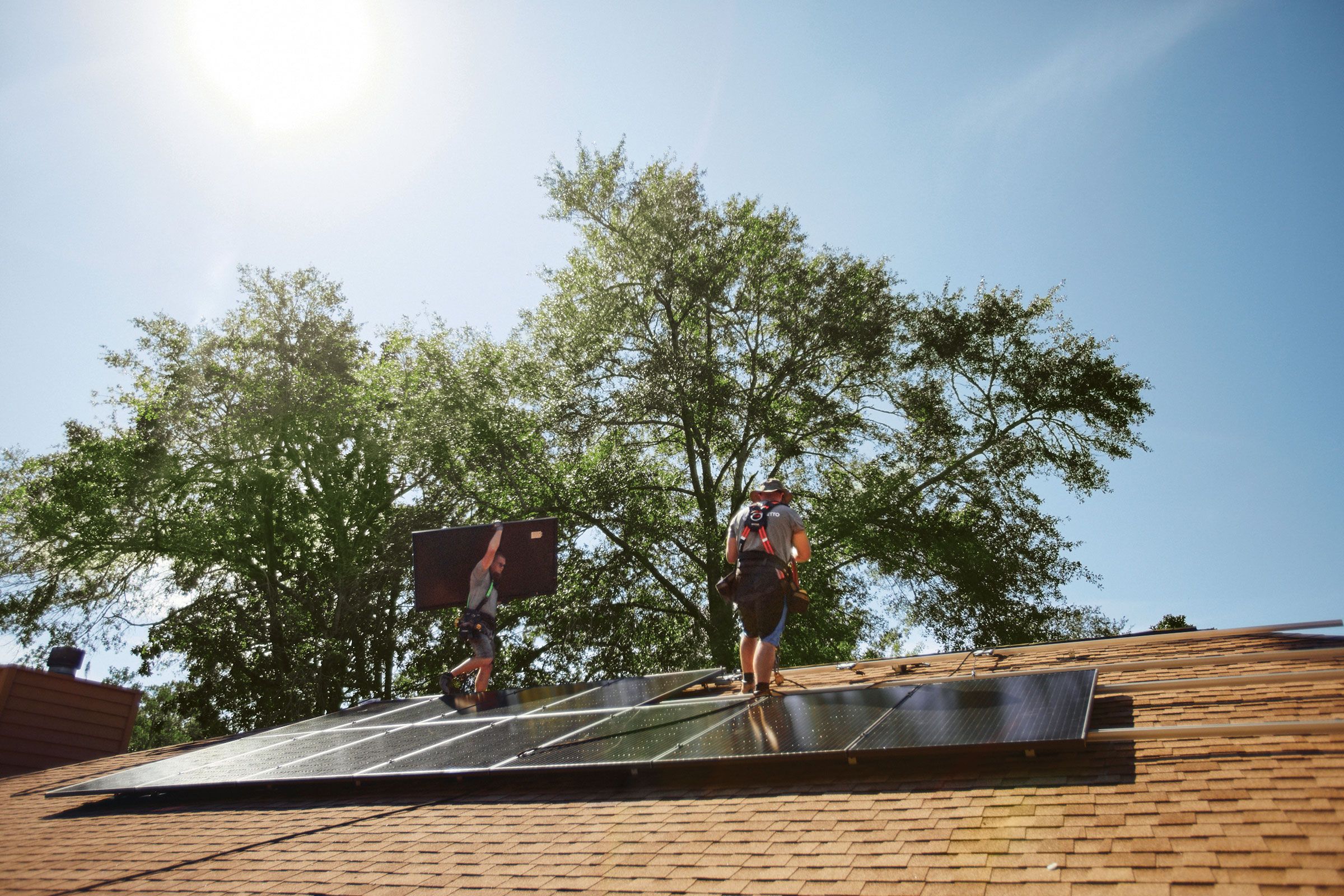
Here’s what to keep in mind when choosing a company to put in your solar power system:
- Get at least three bids—five is better for a full picture of the options and prices—from companies referred by friends, neighbors, or tradespeople you trust.
- The bids should include the federal tax credit and any available local incentives, but you can check what’s available in your area at dsireusa.org. Many solar companies will provide a no-interest loan against your tax credit until the following tax season.
- Check that you’re getting all-black monocrystalline panels with a hidden racking system. Don’t worry about the brand or country of manufacture, says engineering professor Joshua Pearce of Western University. Just make sure the panels are under warranty for at least 25 years, if not 30 years.
- Have your attic evaluated before the bid is finalized to make sure the framing can handle the weight of the array (about 40 pounds per panel)—a problem only if you have undersized or damaged rafters—and see if you can include any needed reinforcement in the installed price (which may yield you a tax credit on that work, too).
Use an online shopping tool
EnergySage is an online solar marketplace that was developed with funding from the U.S. Department of Energy to promote the most affordable, accessible solar. Users simply enter their address on the site to get custom bids from multiple prescreened local companies, along with EnergySage’s apples-to-apples comparison and ratings of each proposal’s products, pricing, and net savings, as well as the contractors themselves.
EnergySage customers pay an average of about $5,000 less for their solar systems, after incentives. “That’s because the solar company is spending significantly less on marketing and sales to find customers,” says CEO and founder Vikram Aggarwal. “Installers on the site tend to offer prices that are 10 to 30 percent lower than anywhere else.” EnergySage users can also upload a quote they received elsewhere for comparison and advice. And all these services are free. Ask for all-black monocrystalline panels without obvious white grid lines.
Types of Inverter Technology
The biggest difference between solar proposals is often the inverter technology. Inverters take the direct current (DC) produced by the PV panels and change it to alternating current (AC) to power your house. There are several ways to do that, each with its own advantages and disadvantage.
Best for affordability: String inverters

Your solar panels are “strung” together like Christmas tree lights and connect to a single inverter either on the side of the house or in the basement. This technology has been used for decades and is the lowest-cost option; however, a string inverter typically lasts only 10 to 12 years, so expect to spend around $1,000 to replace it a couple of times during the 30-year life of the solar array.
Also, because the panels are all linked together, system performance is drastically compromised if they receive differing amounts of light, either because of partial shade or if a panel goes bad. And the high-power DC wiring that comes down from the roof needs to be encased in a heavy-duty aluminum conduit.
Best for multiple roof pitches and yards with trees: Microinverters
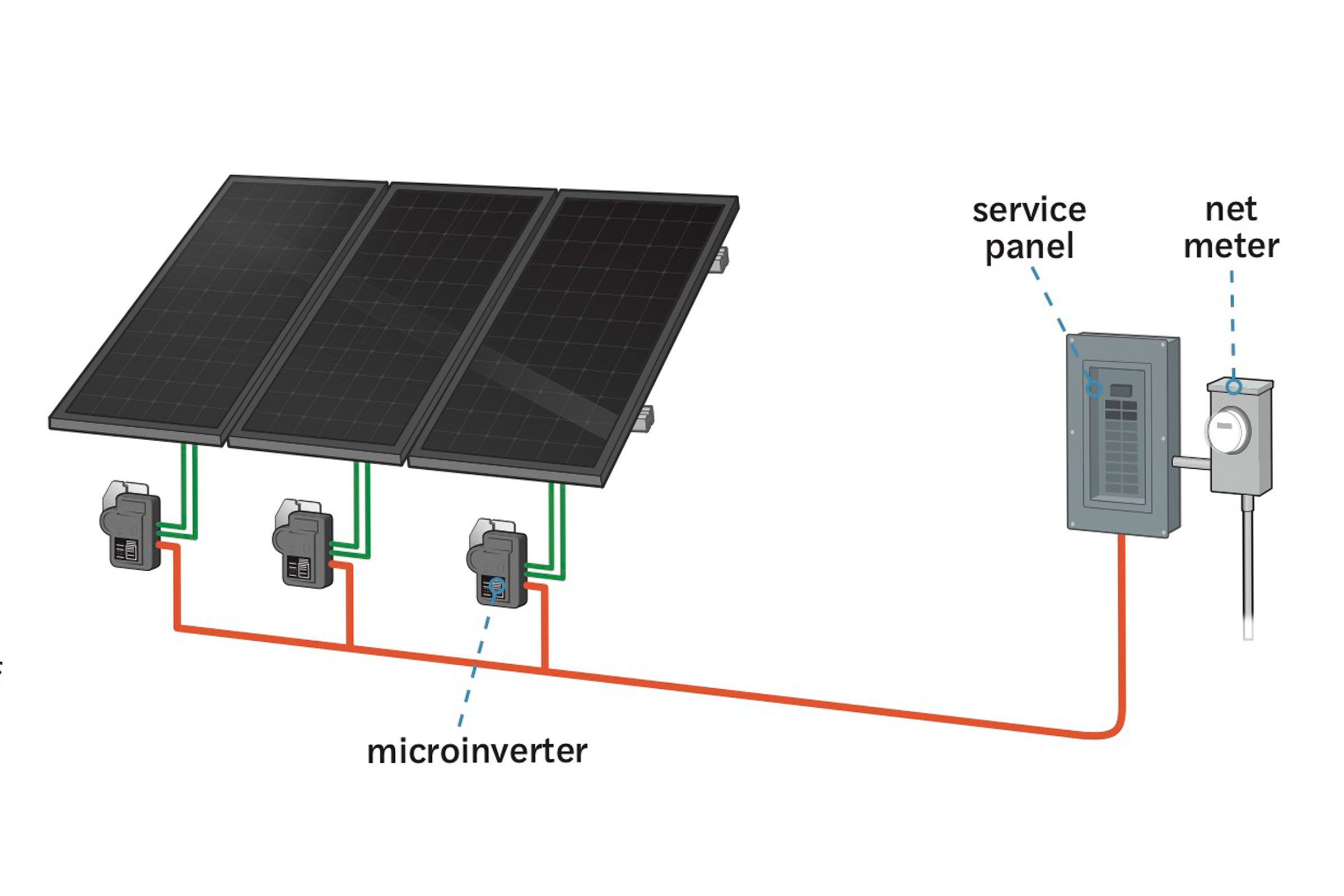
Each solar panel gets its own microinverter wired underneath it, providing several advantages: The system can function well even when panels are experiencing different amounts of sunlight or if one goes down entirely; there is no large inverter to find a place to install; and the standard AC wiring that comes down the side of the house doesn’t require a hefty conduit.
Plus, the system can monitor individual panel performance to identify problems. Microinverters, such as those from Enphase, typically add about $1,000 to the cost of the solar system, but the warranty on microinverters should match the full 25-year term of the solar roof warranty.
Best for Battery Backups: DC optimizers with string inverters
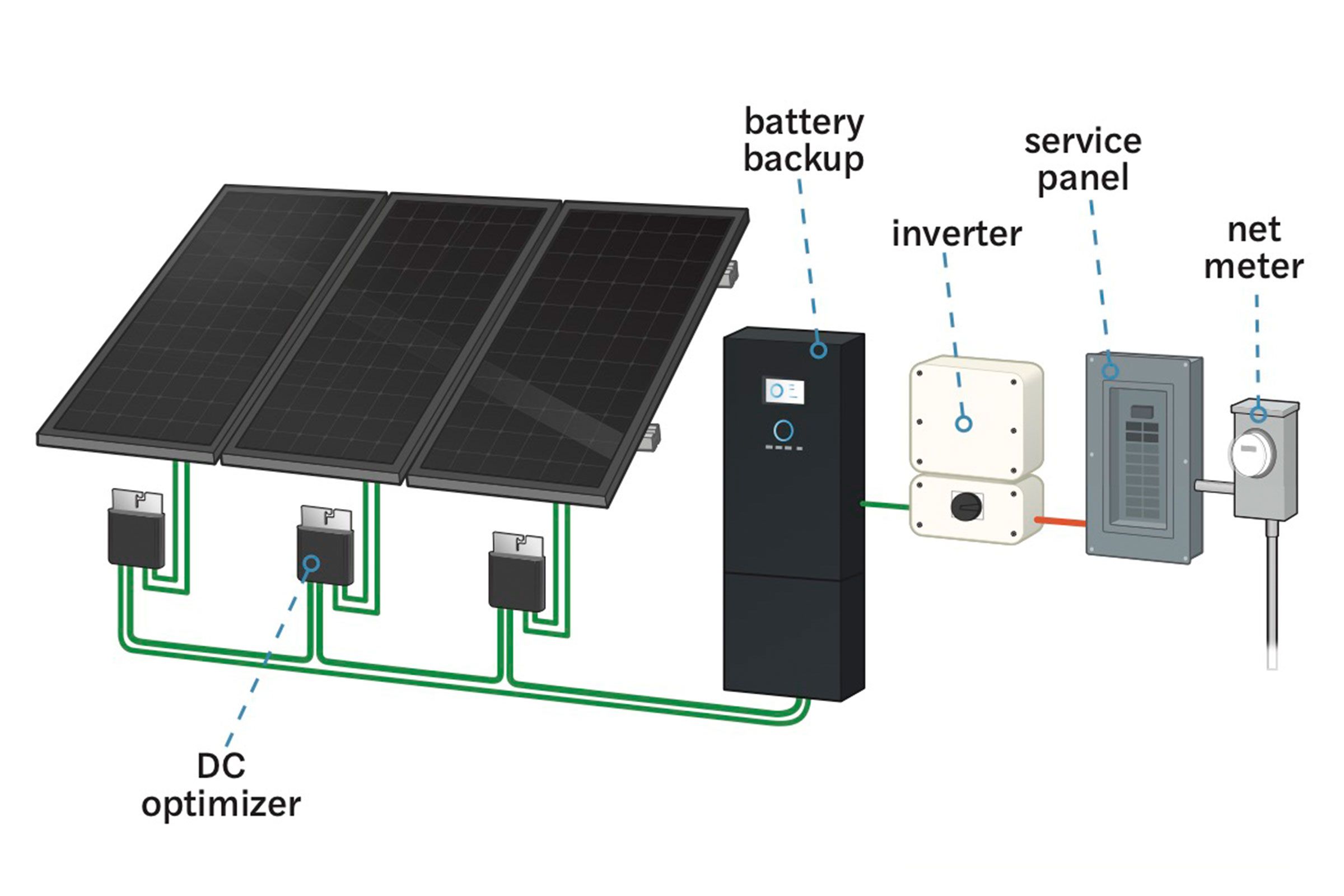
If you’re installing a battery with your solar system, consider DC optimizers. Each solar panel gets its own optimizer, with panel-level performance benefits and diagnostic tools similar to a microinverter’s, but the network still connects to a string inverter.
The big advantage of a DC-coupled system is that the DC power gets routed straight to the battery, and is converted to AC only when it’s pulled from the battery for use, simplifying the system and providing maximum efficiency. DC optimizers, such as those from SolarEdge, typically add a few hundred dollars over the cost of string inverters and have a 25-year warranty. But you’ll still need to replace the inverter a couple of times over the course of the array’s life.
Backup Batteries
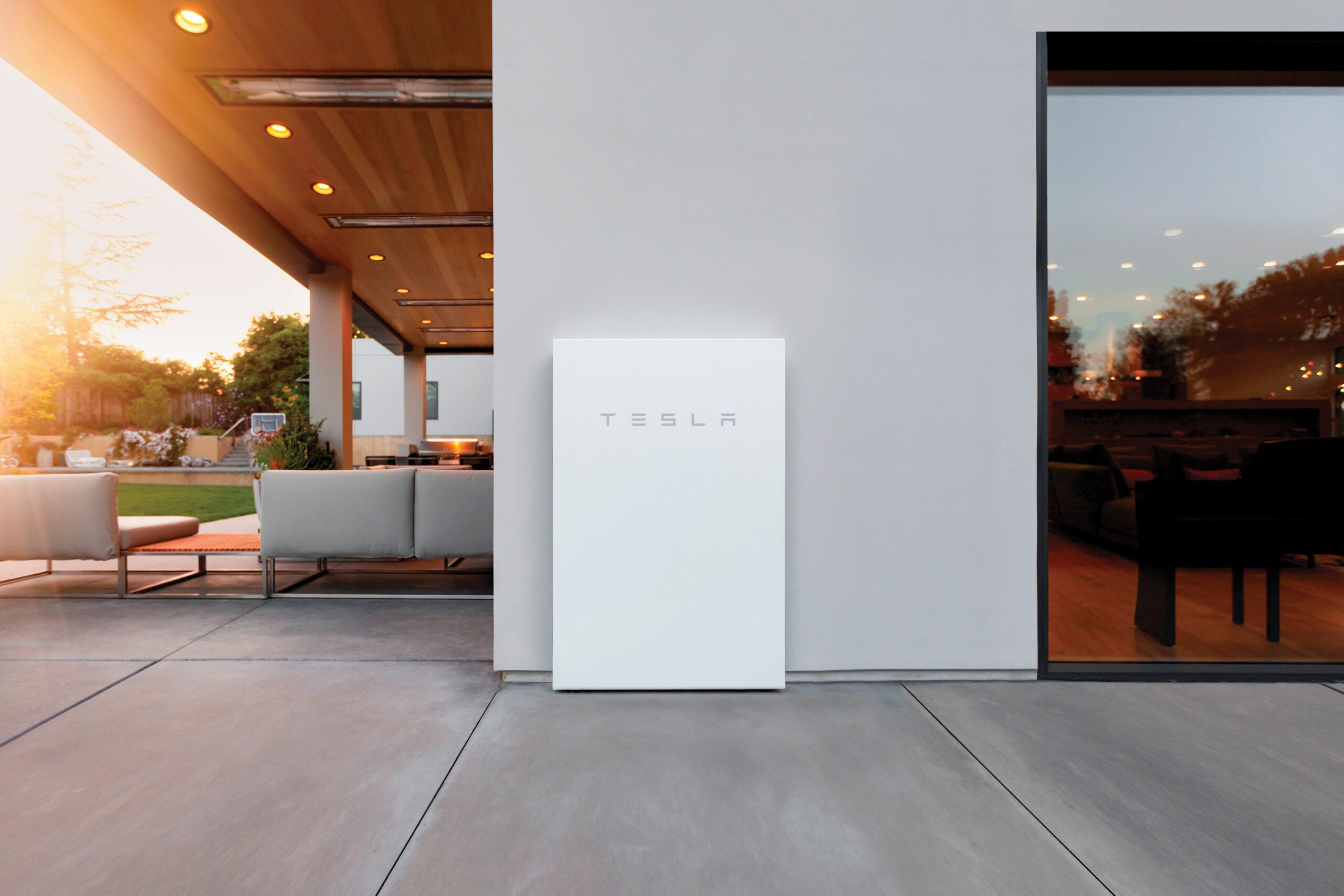
“Most people are surprised to learn that solar arrays won’t provide power during utility blackouts,” says Pearce. But it makes sense. They shut down when the grid does because they would otherwise send power into downed wires and could electrocute pole workers.
In areas with frequent outages, there’s a workaround: whole-house batteries. The excess power your panels create charges your batteries first, and then any additional electricity goes to the grid. When the sun goes down—or the grid goes down—you draw power from the batteries.
In general, a battery backup designed to power the whole house will double the cost of your solar system, Pearce says. The cost of a solar battery system sized for powering just essential circuits like the fridge, Wi-Fi, and key lights and outlets might net out at around $9,500, after incentives. As long as you include the batteries during the solar installation, that work also qualifies for the federal tax credit and any other available incentives.
Consider a large battery
Is your next car going to be an EV? Are you planning to install central air this year? The time to contemplate any big near-term additions to your electrical needs is before you install solar because expanding an existing system later can be costly and problematic, says Los Gatos, CA, solar installer and energy podcaster Barry Cinnamon. You’ll likely need to replace the inverter, and the new panels won’t match the existing ones. “Panel designs change about as quickly as flat-screen TVs,” says Cinnamon.
Sizing the solar array for your future needs means, in the short term, you’ll be generating more power than you consume—and almost surely won’t be able to turn a profit on the net extra power you’re putting out onto the grid. Few utilities will actually make a cash payment to their customers, so overbuild only for expanded usage you foresee happening within two or three years. Some states and utilities won’t allow oversizing a solar system at all, in which case, you should consider holding off on solar until you make those electrification upgrades—and do them soon, so you’ll still be eligible for the federal solar credit.
Where Should You Place Solar Panels?
The best place for solar panels is a south-facing roof—since in the Northern Hemisphere the sun is always in the southern half of the sky—without any shade. But you can get plenty of power from east- or west-facing roofs, too. You could also consider other structures, such as a freestanding garage, barn, shed, or pergola oriented toward the sun, for at least some of your panels—or even a ground-mounted array if you have space on your property. Wherever you put them, your installer can also maximize power output by angling the panels toward the sun, typically somewhere between 30 and 45 degrees, depending on your latitude.
Solar without the install
What if your, house is in deep shade, you live in an apartment or condo, or your home faces south and you are unwilling to put panels out front? In 40 states (and counting), you can participate in a community solar program that generates your electricity at a solar farm for a discounted price—typically about 10 percent less than conventional utility-supplied power.
Not huge savings, to be sure, but there’s no upfront cost, all it takes is a few mouse clicks, and you’ll drastically reduce your carbon footprint and support the growth of solar- energy generation in your area. There’s no change to your electrical service: You still get your power using your existing lines; the green energy you buy just gets added to the utility’s supply.
Solar Hot Water
Other than passive solar, which takes advantage of sunshine on the roof or coming through windows to warm the house, the first solar technology was solar hot water. Popularized during the 1970s energy crisis and still available today, this involves a loop of water from your water heater or boiler—or more commonly, a closed circuit of heat-transfer fluid—running through a grid of pipes in a panel on the roof, getting warmed by the sun, and then preheating the water heading into your water heater or boiler.
Though this is far cheaper than PV panels, typically about $6,300 after incentives, it’s not a common choice anymore. Says Pearce: “Because both photovoltaic panels and electric heat pumps have become so efficient and affordable, it’s now cheaper to heat your hot water with a heat pump using electricity you generate on the roof, than to warm that water on the roof.”
Tips to Prep Your Home for Solar Panels
If the time isn’t right to go solar just yet, Ross suggests taking a few simple steps that will make the job easier down the road:
If you’re gut renovating
Run rigid metal conduit from the attic to the basement, near the electrical service panel. This will avoid the solar installer having to mrun that conduit very visibly down the outside of your house.
If you’re roofing
Make sure your roof structure is solid. While a house built in the last 30 years likely won’t be a problem, with an older home or one with 2×4 rafters, have a structural engineer verify that it offers enough support. Have rafters inspected mfor any damage and repaired or beefed up as needed. Relocate all penetrations—including stacks, bathroom vents, and cooktop vents—away from the area where the solar array would go, so thepanels can be installed in a regular and even pattern—rather than awkwardly wending around those penetrations.
If you’re finishing the basement
Leave about 5 linear feet of wall space near your electrical service panel for the inverter (and solar meter, if needed). That way you won’t need to stick it on the outside of your house, and you’ll have space for a battery in the future.
The Future of PV technology
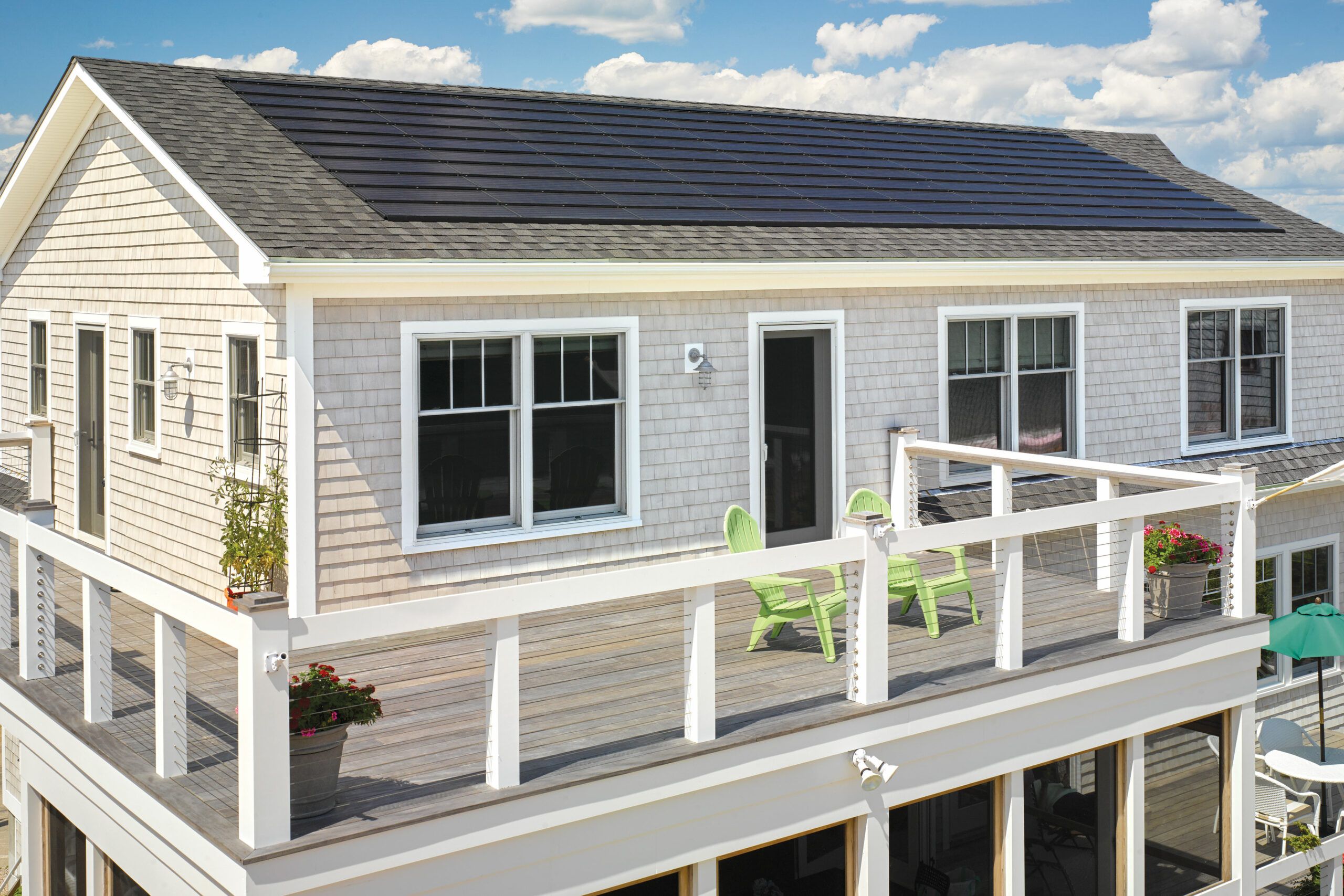
New faux-slate roofing from Tesla, CertainTeed, GAF, SunTegra, Luma, and others has PV cells built right into the shingles. So your roofing is your solar array, and you need no panels mounted on your roof. Some companies even offer matching nonsolar shingles you can use for parts of the roof where you don’t need solar. But despite the advances these products have made, Ross advises caution for now:
“Since we’ve seen some failures, and we’re talking about the weather seal for your house, I would recommend waiting for future generations of these products.” Solar shingles are just the beginning of a new generation of PV technology that will be incorporated into the building itself. Already in production: early versions of windows that have transparent dyes in the glass that absorb ultraviolet and infrared light and turn them into electricity while allowing visible light to pass into the house. Eventually, solar may be integrated into a home’s exterior cladding, patio pavers, awnings, and virtually any part of the house that gets sunshine. Solar shingles are worth considering if you want to benefit from solar energy but don’t like the bulkier aesthetic of solar panels.
